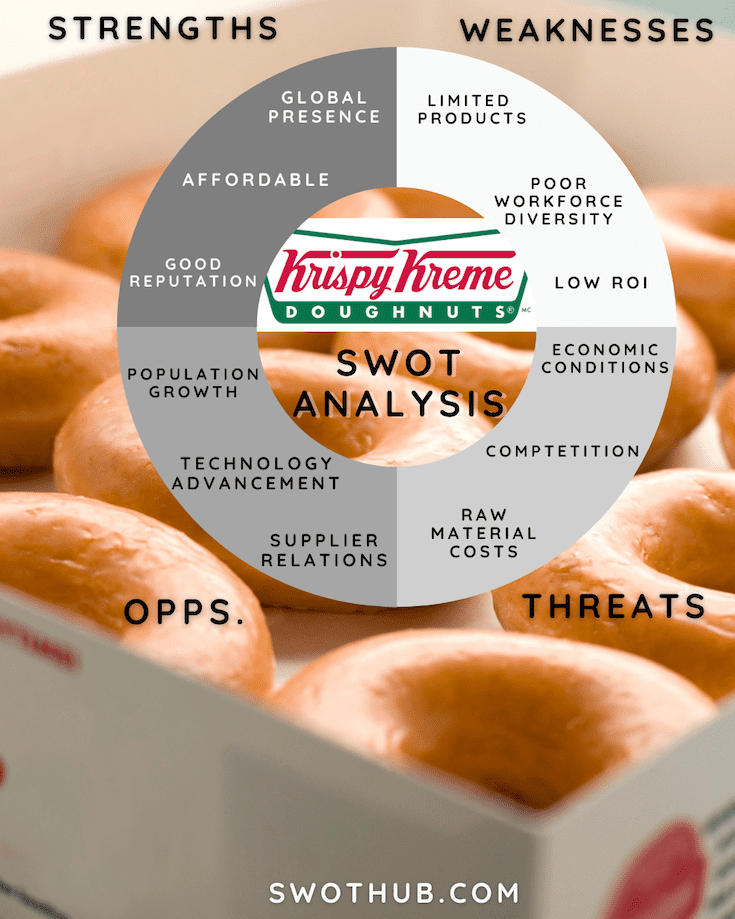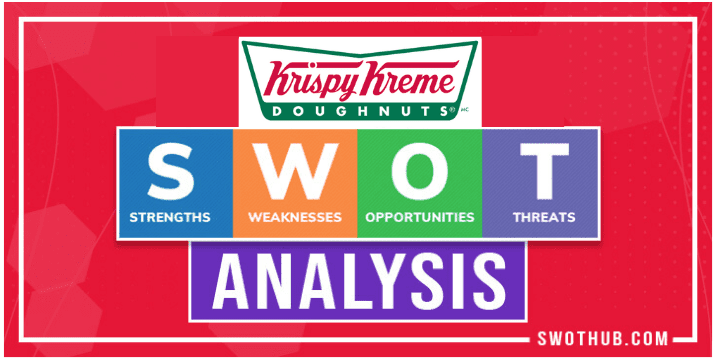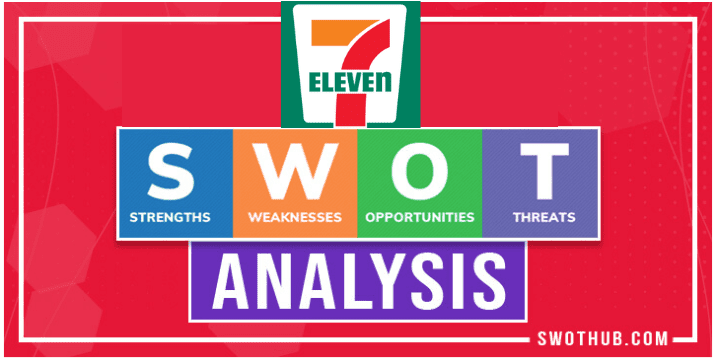Who doesn’t love the sweet and delicious taste of doughnuts? Often spelled donuts, Dunkin Donuts isn’t the only company to become famous for its bakery creations. A Krispy Kreme SWOT analysis helps us understand how this company started and continues to perform in the world of donut shops. Doughnuts and coffee shops have become lucrative businesses over the last ten years, and in this Krispy Kreme SWOT analysis, we look at their strengths, weaknesses, opportunities, and threats against Krispy Kreme competitors.
Table of Contents
Krispy Kreme History
Krispy Kreme Doughnuts sells high-quality and tasty sweet delights all around the world. The company has its headquarters in Winston-Salem, North Carolina, and since its foundation in 1937, Krispy Kreme has provided mouth-watering doughnuts and coffee. The fundraising initiative at Krispy Kreme Doughnuts, which has for years assisted charities in obtaining millions of dollars in required funding, is one of the great initiatives by Krispy Kreme.
In the United States, there are about 12,000 grocery, convenience, and mass merchant stores that sell Krispy Kreme doughnuts. The company operates over 1,400 retail locations, including in the Pacific Northwest of the USA, and in 33 nations. Krispy Kreme offers cake and filled doughnuts, crullers, and fritters in addition to its traditional glazed version, along with hot coffee and other beverages.
Krispy Kreme SWOT Analysis – AT A Glance
| Company Name | Krispy Kreme |
| Industry | Food |
| Founded | 1937 |
| Founders | Vernon Rudolph |
| CEO | Michael J. Tattersfield |
| Headquarter | Charlotte, NC |
| Annual Revenue | US$518.714 million (2016). |
| Website | http://www.krispykreme.com/ |
SWOT Analysis of Krispy Kreme Doughnuts
Krispy Kreme Donuts – A Donut Shop
A competitive strategy tool, the SWOT analysis of Krispy Kreme investigates the company’s strengths, weaknesses, opportunities, and threats. In the Krispy Kreme SWOT analysis, opportunities and threats are external factors, whereas strengths and weaknesses are internal ones. The strengths, weaknesses, opportunities, and threats of a company must unquestionably be taken into account.
A SWOT analysis is performed to completely understand these factors and make wise decisions. A company’s performance can greatly benefit from a SWOT analysis. Krispy Kreme operates similarly. A SWOT analysis is necessary if management is interested in making a decision. A company like Krispy Kreme can use the tried-and-true management framework of SWOT analysis to benchmark its operations and performance with respect to the market. The SWOT analysis of Krispy Kreme is the topic of today’s discussion.
Krispy Kreme Strengths in SWOT Analysis
Strengths are those characteristics, qualities, and features of a company that have a beneficial impact on the company. The strengths comprise the worker’s aptitude, creativity, brand image, customer base, and many other crucial elements. Krispy Kreme shops are well-known for their freshly made, hot-out-of-the-fryer glazed doughnuts. We will talk about a handful of these in today’s SWOT analysis of Krispy Kreme.
Global presence: The Company operates in different nations, which is a plus because it highlights not only its ability to make a profit but also its influence on diverse economies. Krispy Kreme has locations in the United States, South Africa, Thailand, Russia, Mexico, and many more countries. It determines the reach of the firm to the target market and ensures easy accessibility.
Strong IT structure: A well-developed and efficiently integrated IT infrastructure can increase operational efficiency and understanding of current market trends. The modern IT structure helps in establishing a strong online presence on various social networking sites, and effective social media management can boost the influence of positive e-WOM and generate strong customer relationships.
Good reputation: In a competitive market, high product quality enhances brand loyalty and improves Krispy Kreme Doughnut’s performance. Its powerful and recognized brand name and its longevity in the market are important characteristics that contribute to the company’s reputation.
Affordable: Krispy Kreme doughnuts are incredibly popular due to their low prices. The one-of-a-kind signature of the company’s doughnuts at such low prices attracts a large number of customers and demonstrates the market potential of the company’s services.
Krispy Kreme’s Weaknesses in SWOT Analysis
A firm will always have trouble spots where it has to make adjustments; these are the places where the company is thought to be weak. No business is flawless in every industry. Similar to a company’s strengths, its weaknesses are fundamental qualities that must be managed inwardly. The next section of the Krispy Kreme SWOT analysis goes into greater detail on the company’s shortcomings.
Limited products: Products are limited, which could be a negative aspect for Krispy Kreme. They only sell doughnuts and coffee. Due to their limitations, Krispy Kreme may not always rank first when customers are looking for things to hydrate them during different seasons, such as the summer.
Franchise dependence: Krispy Kreme depends heavily on franchisees to run its shops. While this may speed up the company’s expansion, it may also lead to inconsistent quality and customer care in various locations.
Exposure to health trends – With a growing emphasis on healthy eating, Krispy Kreme’s products, which are high in calories and sugar, may not appeal to consumers who are interested in healthy eating. The company’s long-term growth may be hampered by this.
Perception of being a “fad” – The popularity and rapid growth of Krispy Kreme in the early 2000s led some people to perceive it as a “fad,” and this perception persists today. Despite the fact that the company has since expanded and grown, this perception might hurt its standing and potential future expansion.
Although Krispy Kreme is well known for its doughnuts, its menu is relatively small in comparison to some of its rivals. The inability to offer a wider selection of food and beverages may make it harder to draw in customers.
Poor Workforce diversity: Lack of diversity in the Kreme Krispy workforce can hinder the company’s chances of success in the international market given that the majority of its growth to date has occurred in the domestic market due to poor management planning and workforce diversity which can also lead to future financial instability.
Low Return on Investment: Despite having a strong balance sheet, Kreme Krispy should consider improving its “Return on Invested Capital” rating. Returns on investment are one of the key factors that contribute to financial instability.
Low budget: Lack of funding for marketing and promotion efforts makes it harder for businesses to attract new customers and promote ongoing business. Advertisement of products plays an important role in boosting the sale of Krispy Kreme, so it is also considered one of the company’s weaknesses.

Opportunities for Krispy Kreme in SWOT Analysis
The external environment has effects on a company’s success, just like internal factors do. Opportunities are potential outcomes of the external environment that could benefit the business. These opportunities have the potential to significantly influence a company’s performance and level of success. No doubt about it, opportunities abound at Krispy Kreme. Today, we’ll discuss a few of the ones listed below in the Krispy Kreme SWOT Analysis:
Increased focus on coffee – Krispy Kreme has been making investments in its coffee offerings even though it is primarily known for its doughnuts. The opportunity for Krispy Kreme to grow its coffee business and compete with other coffeehouse chains exists given the continued expansion of the global coffee market.
Innovation in flavors and products – For years, Krispy Kreme has been renowned for its unique product offerings, including its seasonal doughnuts and limited-edition collaborations. Maintaining relevance and bringing out new, exciting flavors and products can help the business draw in new clients.
Online and mobile ordering – With the rising popularity of online and mobile ordering, Krispy Kreme has the chance to diversify its digital offerings and streamline the ordering and delivery process for customers.
Partnerships and collaborations – In the past, in a Krispy Kreme SWOT analysis, it has partnered and collaborated with businesses like Oreo and Nutella, which have been effective at building buzz and luring new customers. The company has the chance to keep forming these alliances and partnerships to offer its clients fresh flavors and goods.
Strong relationships with current suppliers: As a market leader, Kreme Krispy has strong relationships with its current suppliers and other supply chain participants, which is also considered a major opportunity for future company success.
Population Growth: The Worldwide population’s exponential increase, especially in the existing or potential customer segments where Krispy Kreme operates, it presents a significant opportunity for Krispy Kreme Company to expand.
Technological advancement: To integrate innovation into business practices, developing new technologies to help produce and distribute products and services may be useful. Advanced technological integration can increase productivity, reduce costs, and facilitate the introduction of new goods.
Government subsidiaries: A favorable external environmental aspect for Krispy Kreme Doughnuts is the government’s subsidies and other initiatives to improve the business climate.
Krispy Kreme SWOT Analysis Threats
External factors are not always favorable and attractive, and some of their aspects can be very challenging to manage. An external factor that negatively impacts a company is referred to as a threat. Threats are a component of the microenvironment of a business. Every company, including Krispy Kreme, faces threats. In the portion of the Krispy Kreme SWOT Analysis below, we’ll look at a few.
Competition – With several major players like Dunkin’, Tim Hortons, and Starbucks, as well as numerous smaller regional and local rivals, the market for donuts and coffee is extremely competitive. It may be challenging for Krispy Kreme to draw in and keep customers in light of this competition.
Health trends – Krispy Kreme’s products, which are high in sugar and calories, might not be appealing to consumers who are becoming more concerned with eating healthily. Over time, this trend might have an impact on the demand for Krispy Kreme’s products.
Diversify product offerings – Gourmet donut shops frequently feature original recipes and specialty beverages. To attract a wider clientele, Krispy Kreme should broaden its product line beyond doughnuts. It might, for instance, start serving coffee, tea, and other libations, breakfast sandwiches, or other foods.
Complex regulatory framework: The implementation of new, stricter restrictions and the changing regulatory framework seriously endanger Krispy Kreme. It complicates and makes it harder for the corporate organization to comply with the law.
Raw Material Cost: The margins for Krispy Kreme may suffer from rising raw material costs, which potentially pose a threat to the company’s market position in the future.
Economic conditions: As a result of the Pandemic, the global economy is suffering. The economy’s health directly impacts consumer spending patterns and purchasing power, which in turn affects how well firms function.
Who are Krispy Kreme’s Competitors?
While Krispy Kreme’s competitors include local donut shops in local areas, on a global level, here are their biggest competitors:
- Dunkin’ – Founded in the 1950s, previously known as Dunkin’ Donuts, is a multinational coffee and donut company. More than 12,000 Dunkin’ Donuts locations exist in the world. Visit the Dunkin Donuts SWOT analysis here.
- Tim Hortons is a multinational Canadian fast-food restaurant that serves coffee, doughnuts, and other breakfast foods. Tim Hortons has over 4,000 locations worldwide.
- Starbucks – has more than 30,000 locations worldwide and is an American multinational coffeehouse chain. Although Starbucks doesn’t focus on making doughnuts, they do offer a variety of baked goods, including doughnuts.
- Panera Bread is an American bakery-café chain that offers freshly baked bread, pastries, sandwiches, and salads. They also serve coffee and other beverages and they have over 2,000 locations worldwide.
Conclusion and Recommendations for Krispy Kreme SWOT Analysis
- Introduce healthier and more specialized doughnut options, such as gluten-free and vegan, to appeal to a wider audience.
- For health-conscious customers, expand beverage offerings to include organic teas and smoothies.
- To match consumer expectations, use sustainability initiatives such as local sourcing and waste minimization.
- Improve customer engagement by enhancing digital platforms with AI recommendations, loyalty programs, and faster online ordering.
- To expand reach, collaborate with e-commerce platforms to provide fast delivery services.
- Investigate co-branding options with complementary brands to generate new revenue.
FAQs for Krispy Kreme SWOT Analysis
What is the Krispy Kreme hub-and-spoke model?
The hub-and-spoke model involves a central production facility (the hub) that makes doughnuts in large volumes. These are then distributed to smaller retail outlets (the spokes) for sale. This centralizes production and helps maintain product consistency.
What are the disadvantages of owning a Krispy Kreme franchise?
Initial costs can be high, including franchise fees and the expenses related to building and outfitting a store. You’re also bound by the company’s rules and have limited creative control over the product line or marketing.
What is Krispy Kreme’s mission?
Krispy Kreme’s mission is to “touch and enhance lives through the joy that is Krispy Kreme.” It aims to offer high-quality doughnuts and create joyful experiences for customers.
One of the oldest doughnut and coffee companies is still in high demand because of its delicious range of products. It is concluded from the article that Krispy Kreme Company should focus on its competitive advantages. Due to the intense competition in the bakery and coffee markets, it is recommended that Krispy Kreme make continual efforts to maintain its existing market share. Secondly, the affordable pricing range of Krispy Kreme’s doughnuts and coffee, as well as its appealing branding strategies and logo, are some of the factors that could provide considerable customer value in the market.





